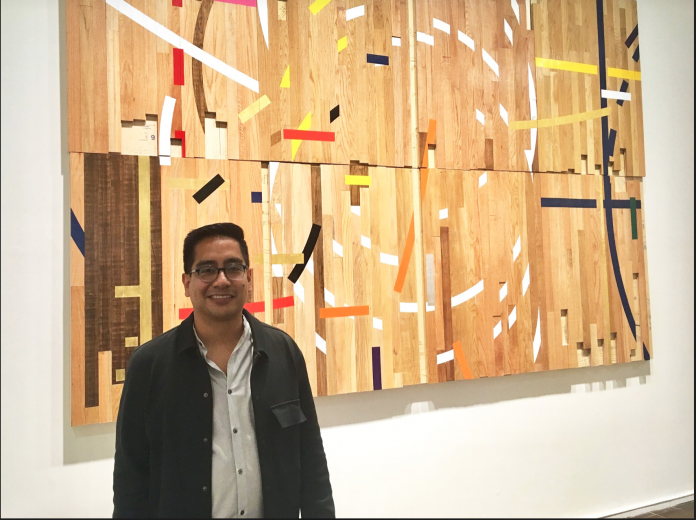The opening reception for artist Ronny Quevedo’s exhibition, “Space of Play, Play of Space,” was held in the Martin Art Gallery in the Baker Center for the Arts on Wednesday, Sept. 18, from 5:30pm-7:00pm. Quevedo’s work is primarily on display in the Martin Art Gallery; however, there is also a field-sized drawing on the lawn adjacent to the Trexler Library on campus, and visitors are encouraged to directly engage with the work by walking on the field.
Quevedo is an internationally recognized artist. His work has been exhibited at a variety of different locations, including The Whitney Museum of Art, the Queens Museum, and The Bronx Museum of the Arts, among others. Quevedo has also achieved numerous recognitions for his art, including the 2017 Blade of Grass Fellowship for Socially Engaged Art and the 2016 Queen Museum/Jerome Foundation Fellowships for Emerging Arts, as well as being published in “Hyperallergic” and “Art Forum”.
Students, faculty, and community members attended the opening reception. Light refreshments were served; and attendees spent their time mingling, snacking and looking at the exhibition. The pieces on display exemplified Quevedo’s mastery of various materials. The artwork in the exhibition was aesthetically situated in the gallery area to allow for plenty of room for attendees to gather around and discuss various pieces.
“I was always drawing when I was a kid,” said Quevedo. “If I didn’t get a specific toy or something that I wanted I would just make it out of cardboard or draw it myself. As a kid, I was always working on things, and slowly I was able to develop it and go to school in New York for art and do my undergrad at Cooper Union. I think I was always interested in creating things out of rare or different objects. I get to invent and reinvent over and over and use different materials. It doesn’t get boring.”
Quevedo’s father was a professional soccer player in Ecuador. When his family came to the United States, Quevedo’s father became a referee for amateaur soccer leagues.
“I would travel with him and visit a whole bunch of sites all the time, so I got a really different sense of sports through that interaction,” said Quevedo. “It wasn’t just about competitive nature. There was also a social structure around it — people playing games, joining teams, eating specific types of foods — turning it into a ritual. That is where my connection to sports comes into play. It’s also a way of looking at how these borders can be renegotiated: thinking about sharing things with people. This international game of soccer, for example, is one that is not necessarily limited by borders, yet at times is informed by the borders that these countries represent.”
Muhlenberg students Jenny Moretti ‘22 and Katrina Ussia ‘22 attended the reception. “It has been cool trying to do The Method [an analytical technique used to comprehend texts] on the artwork, like trying to find strands. We started off with listing the various materials we saw in the pieces, like wood, tape and foil,” said Moretti, “and then Katrina noticed the athletic aspects in the first piece to the left.”
“I noticed a field,” said Ussia. Moretti and Ussia found it intriguing that imagery of fields and boundaries were present in most of the works on display in the gallery.
Quevedo’s exhibition is a compilation of various works that he has created over the past seven years. “These are works that are generally connected through the role of sports or playing fields,” explained Quevedo. “When I got the opportunity for this exhibition, I decided to pick a few of them that would make the most sense together.”
Mirna Trauger, an assistant professor of Spanish at Muhlenberg, asked her students to attend the exhibition opening of “Space of Play, Play of Space” because of Quevedo’s Latin American descent and his exploration of the interplay between spaces and their meanings. Examining one of Quevedo’s pieces, Trauger said, “I see two sides divided by a border down the middle that are very similar but somewhat diverse as well. It makes me think of the similar humanity on both sides of our border. We have so many things in common, yet we are different; hopefully, it is not our differences that separate us, but that bring us together.”
“Space and Play, Play and Space” will be on display in the Martin Art Gallery and on the lawn near the Trexler Library through Nov. 2. Quevedo will give an artist talk on Tuesday, Oct. 15, at 7:00pm in the Recital Hall in the Baker Center for the Arts as part of the Center for Ethics 2019-2020’s Borders, Nationalisms, Identities: The Ethics of Global Citizenship program.






















